American lobster
| American lobster Temporal range: Pleistocene–Recent | |
|---|---|
 | |
| Scientific classification | |
| Kingdom: | Animalia |
| Phylum: | Arthropoda |
| Subphylum: | Crustacea |
| Class: | Malacostraca |
| Order: | Decapoda |
| Family: | Nephropidae |
| Genus: | Homarus |
| Species: | H. americanus |
| Binomial name | |
| Homarus americanus H. Milne-Edwards, 1837 | |
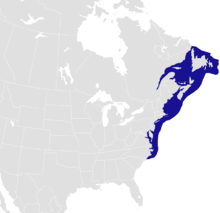 | |
| Natural range of H. americanus (blue) | |
| Synonyms [2] | |
| |
The American lobster, Homarus americanus, is a species of lobster found on the Atlantic coast of North America, chiefly from Labrador to New Jersey. It is also known as Canadian lobster, true lobster, northern lobster, Canadian Reds,[3] or Maine lobster.[4][5] It can reach a body length of 64 cm (25 in), and a mass of over 20 kilograms (44 lb), making it not only the heaviest crustacean in the world, but also the heaviest of all living arthropod species. Its closest relative is the European lobster Homarus gammarus, which can be distinguished by its coloration and the lack of spines on the underside of the rostrum. American lobsters are usually bluish green to brown with red spines, but several color variations have been observed.
Distribution
Homarus americanus is distributed along the Atlantic coast of North America, from Labrador in the north to Cape Hatteras, North Carolina in the south.[6] South of New Jersey, the species is uncommon, and landings in Delaware, Maryland, Virginia and North Carolina usually make up less than 0.1% of all landings.[7] A fossil claw assigned to Homarus americanus was found at Nantucket, dating from the Pleistocene.[8][9] In 2013, an American lobster was caught at the Farallon Islands off the coast of California.[10]
Its also an invasive species in Sweden and its affecting the populations of native lobster species
Description
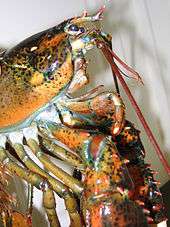
Homarus americanus commonly reaches 8–24 inches (200–610 mm) long and weighs 1–9 pounds (0.45–4.08 kg) in weight, but has been known to weigh as much as 44 lb (20 kg), making this the heaviest crustacean in the world.[11] Together with Sagmariasus verreauxi, it is also the longest decapod crustacean in the world;[2] an average adult is about 9 in (230 mm) long and weighs 1.5 to 2 lb (680 to 910 g). The longest American lobsters have a body (excluding claws) 64 cm (25 in) long.[2] According to Guinness World Records, the heaviest crustacean ever recorded was an American lobster caught off Nova Scotia, Canada, weighing 44.4 lb (20.1 kg).[11][12]
The closest relative of H. americanus is the European lobster, Homarus gammarus. The two species are very similar, and can be crossed artificially, although hybrids are unlikely to occur in the wild since their ranges do not overlap.[13] The two species can be distinguished by several characteristics:[14]
- The rostrum of H. americanus bears one or more spines on the underside, which are lacking in H. gammarus.
- The spines on the claws of H. americanus are red or red-tipped, while those of H. gammarus are white or white-tipped.
- The underside of the claw of H. americanus is orange or red, while that of H. gammarus is creamy white or very pale red.
Head
The antennae measure about 2 in (51 mm) long and split into Y-shaped structures with pointed tips. Each tip exhibits a dense zone of hair tufts staggered in a zigzag arrangement. These hairs are covered with multiple nerve cells that can detect odors. Larger, thicker hairs found along the edges control the flow of water, containing odor molecules, to the inner sensory hairs.[15] The shorter antennules provide a further sense of smell. By having a pair of olfactory organs, a lobster can locate the direction a smell comes from, much the same way humans can hear the direction a sound comes from. In addition to sensing smells, the antennules can judge water speed to improve direction finding.
Lobsters have two urinary bladders, located on either side of the head. Lobsters use scents to communicate what and where they are, and those scents are in the urine. They project long plumes of urine 1–2 meters (3 ft 3 in–6 ft 7 in) in front of them, and do so when they detect a rival or a potential mate in the area.[16]
Thorax
The first pair of pereiopods (legs) is armed with a large, asymmetrical pair of claws.[2] The larger one is the "crusher", and has rounded nodules used for crushing prey; the other is the "cutter", which has sharp inner edges, and is used for holding or tearing the prey.[14]
Coloration
The normal coloration of Homarus americanus is "dark bluish green to greenish brown", redder on the body and claws, and greener on the legs.[6] This coloration is produced by mixing yellow, blue, and red pigments.[17] Despite the rarity of strangely colored lobsters, many more of them are reported being caught. It is unclear as to whether this is an artifact of social media (i.e. it is easier to report catching a strangely colored lobster), or if it is due to a drop in predator populations.[18]
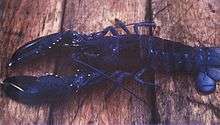

An estimated one in 2 million lobsters are blue.[19] A genetic mutation causes a blue lobster to produce an excessive amount of a particular protein.[20] The protein and a red carotenoid molecule known as astaxanthin combine to form a blue complex known as crustacyanin, giving the lobster its blue color.[21] In 2009 a blue lobster was caught in New Hampshire;[22] in 2011, two blue lobsters were caught in Canada, one off of Prince Edward Island,[23] and another in the Esgenoôpetitj First Nation territory in New Brunswick;[23] another was caught in May 2012 off Nova Scotia.[24] A blue lobster was caught off Pine Point in Scarborough, Maine in August 2014, and was donated to a local aquarium to join 3 other blue lobsters.[25] Most recently, one was caught in Massachusetts off the coast of Cape Cod.[26]
Yellow lobsters are the result of a rare genetic mutation and the odds of finding one are estimated to be 1 in 30 million.[19][27] Reports of yellow lobsters include one off Whaleback Island (at the mouth of the Kennebec River), Maine, on August 1, 2006,[28] off Prince Edward Island, Canada, on June 11, 2009,[29] one discovered in Wainani Kai Seafoods in Kalihi, Hawaii in a shipment from Nova Scotia on April 30, 2010,[30] in Narragansett Bay off Rhode Island on July 31, 2010,[17] and one off the coast of Black Point in Niantic, Connecticut on June 9, 2014.[31]
In July 2010, an albino lobster was reportedly caught in Gloucester.[32] An estimated only one in 100 million lobsters is albino, entirely lacking in colored pigments.[19][32]
On August 28, 2010, a calico lobster with a mottled orange and black shell was reported to have been caught in Maine.[33] Only albino lobsters are rarer, and orange lobsters such as these are a 1 in 30 million catch.[19][34]
Several lobsters have been caught with different colorings on their left and right halves.[35] For instance, on July 13, 2006, a Maine fisherman caught a brown and orange lobster, and submitted it to the local oceanarium,[36] which had only seen three lobsters of this kind in 35 years. The chance of finding one is estimated at 1 in 50 million.[19][37] Many split-colored lobsters observed have been hermaphroditic chimeras,[38] but not all.[39]
Red lobsters are the usual result of a lobster being cooked. There is a 1 in 10 million chance of catching one alive with that color.[19][40]
Life cycle
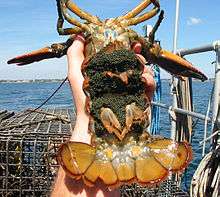
Mating only takes place shortly after the female has molted, and her exoskeleton is still soft.[41] The female releases a pheromone which causes the males to become less aggressive and to begin courtship, which involves a courtship dance with claws closed.[41] Eventually, the male inserts spermatophores (sperm packets) into the female's seminal receptacle using his first pleopods; the female may store the sperm for up to 15 months.[41]
The female releases eggs through her oviducts, and they pass the seminal receptacle and are fertilized by the stored sperm.[41] They are then attached to the female's pleopods (swimmerets) using an adhesive, where they are cared for until they are ready to hatch.[41] The female cleans the eggs regularly, and fans them with water to keep them oxygenated.[42] The large telolecithal[43] eggs may resemble the segments of a raspberry,[41] and a female carrying eggs is said to be "in berry".[41] Since this period lasts 10–11 months, berried females can be found at any time of year.[2] In the waters off New England, the eggs are typically laid in July or August, and hatch the following May or June.[43] The developing embryo passes through several molts within the egg, before hatching as a metanauplius larva. When the eggs hatch, the female releases them by waving her tail in the water, setting batches of larvae free.[42]
The metanauplius of H. americanus is 1⁄3 in (8.5 mm) long, transparent, with large eyes and a long spine projecting from its head.[41] It quickly molts, and the next three stages are similar, but larger.[41] These molts take 10–20 days, during which the planktonic larvae are vulnerable to predation; only 1 in 1,000 is thought to survive to the juvenile stage.[41] To reach the fourth stage – the post-larva – the larva undergoes metamorphosis, and subsequently shows a much greater resemblance to the adult lobster,[43] is around 1⁄2 in (13 mm) long,[41] and swims with its pleopods.[43]
After the next molt, the lobster sinks to the ocean floor, and adopts a benthic lifestyle.[42] It molts more and more infrequently, from an initial rate of ten times per year to once every few years.[41] After one year, it is around 1–1.5 in (25–38 mm) long, and after six years, it may weigh 1 pound (0.45 kg).[41] By the time it reaches the minimum landing size, an individual may have molted 25–27 times, and thereafter each molt may signal a 40%–50% increase in weight, and a 14% increase in carapace length.[42]
Ecology
The American lobster thrives in cold, shallow waters where there are many rocks and other places to hide from predators. It typically lives at a depth of 4–50 m (13–164 ft), but can be found up to 480 m (1,570 ft) below the surface.[2]
Diet
The natural diet of H. americanus is relatively consistent across different habitats. It is dominated by mollusks (especially mussels), echinoderms and polychaetes, although a wide range of other prey items may be eaten, including other crustaceans, brittle stars and cnidarians.[44] Lobsters in Maine have been shown to gain 35-55% of their calories from herring, which is used as bait for lobster traps.[45] Only 6% of lobsters entering lobster traps to feed are caught.
Diseases
Bacterial
Gaffkemia or red-tail is an extremely virulent infectious disease of lobsters caused by the bacterium Aerococcus viridans.[46] It only requires a few bacterial cells to cause death of otherwise healthy lobsters. The "red tail" common name refers to a dark orange discoloration of the ventral abdomen of affected lobsters. This is, in fact, the hemolymph or blood seen through the thin ventral arthrodial membranes. The red discoloration comes from astaxanthin, a carotenoid pigment exported to the blood during times of stress. The same sign is also seen in other diseases of lobsters and appears to be a nonspecific stress response, possibly relating to the antioxidant and immunostimulatory properties of the astaxanthin molecule.
Epizootic shell disease is a bacterial infection which causes black lesions on the lobsters' dorsal carapaces, reducing their saleability and sometimes killing the lobsters.[47]
Limp lobster disease caused by systemic infection by the bacterium Vibrio fluvialis (or similar species) causes lobsters become lethargic and die.[46][48]
Parasitic
Paramoebiasis is an infectious disease of lobsters caused by infection with the sarcomastigophoran (amoeba) Neoparamoeba pemaquidensis. This organism also causes amebic gill disease in farmed Atlantic salmon, Salmo salar. Infection occurs throughout the tissues, causing granuloma-like lesions, especially within the ventral nerve cord, the interstices of the hepatopancreas and the antennal gland. Paramoebiasis is strongly suspected to play a prominent role in the rapid die-off of American lobsters in Long Island Sound that occurred in the summer of 1999.[46]
Environmental
Excretory calcinosis in American lobsters in Long Island Sound was described in 2002. The disease causes mineralized calculi to form in the antennal glands and gills. These cause a loss of surface area around the gills, and the lobster eventually asphyxiates. Several reasons have been proposed for the cause of a recent outbreak of the disease. The most generally attributed factor is an increased duration of warmer temperatures in the bottom of the Long Island Sound.[49][50]
Taxonomy
The American lobster was first described by Thomas Say in 1817, with a type locality of "Long-branch, part of the coast of New Jersey".[2] The name Say chose – "Astacus marinus" – was invalid as a junior homonym of Astacus marinus Fabricius, 1775, which is in turn a junior synonym of Homarus gammarus.[2] The American lobster was given its current scientific name of Homarus americanus by Henri Milne-Edwards in his 1837 work Histoire naturelle des Crustacés ("Natural History of the Crustacea").[2] The common name preferred by the Food and Agriculture Organization is "American lobster", but the species is also known locally as the "northern lobster", "Maine lobster" or simply "lobster".[2]
As food

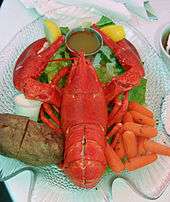
American lobsters are a popular food.[51] They are commonly boiled or steamed. Hard-shells (lobsters that are several months past their last molt) can survive out of water for up to four or five days if kept refrigerated.[52] Soft-shells (lobsters that have only recently molted) do not survive more than a few hours out of water. Lobsters are usually cooked alive,[53] which may be illegal in certain areas[54] and which some people consider inhumane.[55][56]
One common way of serving lobster 'tail' (actually the abdomen) is with beef, known as surf and turf.[57] Lobsters have a greenish or brownish organ called the tomalley, which, like the liver and pancreas in a human, filters out toxins from the body.[58] Some diners consider it a delicacy, but others avoid it because they consider it a toxin source or dislike eating innards.
A set of nutcrackers and a long, thin tool for pulling meat from inaccessible areas are suggested as basics, although more experienced diners can eat the animal with their bare hands or a simple tool (a fork, knife or rock). Eating a lobster can get messy, and most restaurants offer a lobster bib.[59] Meat is generally contained in the larger claws and tails, and stays warm quite a while after being served. There is some meat in the legs and in the arms that connect the large claws to the body. There is also some small amount of meat just below the carapace around the thorax and in the smaller legs.
North American lobster industry
Most lobsters come from the northeastern coast of North America, with the Atlantic Provinces of Canada and the U.S. state of Maine being the largest producers. They are caught primarily using lobster traps, although lobsters are also harvested as bycatch by bottom trawlers, fishermen using gillnets, and by scuba divers in some areas. Maine completely prohibits scuba divers from catching lobsters (violations could result in up to a $1000 fine). Maine also strictly prohibits the landing of lobsters caught by bottom trawlers and other "mobile gear".[60][61] Massachusetts offers scuba divers lobster licenses for a fee, and they are only available to state residents. Rhode Island also requires divers to acquire a permit.
Lobster traps are rectangular cages made of vinyl-coated galvanized steel mesh or wood, with woven mesh entrances. These are baited and lowered to the sea floor. They allow a lobster to enter, but make it difficult for the larger specimens to turn around and exit. This allows the creatures to be captured alive. The traps, sometimes referred to as "pots", have a buoy floating on the surface, and lobstermen check their traps between one and seven days after setting them. The inefficiency of the trapping system has inadvertently prevented the lobster population from being overfished. Lobsters can easily escape the trap, and will defend the trap against other lobsters because it is a source of food. An estimated 10% of lobsters that encounter a trap enter, and of those that enter 6% will be caught.[62]
United States
In the United States, the lobster industry is regulated. Every lobster fisher is required to use a lobster gauge to measure the distance from the lobster's eye socket to the end of its carapace: if the lobster is less than 3.25 inches (83 mm) long, it is too young to be sold and must be released back to the sea. There is also a legal maximum size of 5 in (130 mm) in Maine, meant to ensure the survival of a healthy breeding stock of adult males, but in parts of some states, such as Massachusetts, there is none. Also, traps must contain an escape hole or "vent", which allows juvenile lobsters and bycatch species to escape. The law in Maine and other states dictates a second large escape hole or "ghost panel" must be installed. This hole is held shut through use of biodegradable clips made of ferrous metal. Should the trap become lost, the trap eventually opens, allowing the catch to escape.[63]
To protect known breeding females, lobsters caught carrying eggs are to be notched on a tail flipper (second from the right, if the lobster is right-side up and the tail is fully extended). Following this, the female cannot be kept or sold, and is commonly referred to as a "punch-tail" or as "v-notched". This notch remains for two molts of the lobster exoskeleton, providing harvest protection and continued breeding availability for up to five years.[64]
Canada
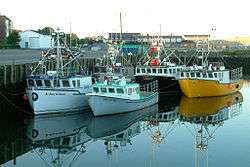
In the late 1990s and early 21st century, lobster fishing was the cause of troubles between Acadians and Mi'kmaq First Nations in the Canadian Maritimes. The Acadian economy (and identity) relied substantially on fisheries, especially lobster. In 1998, the Supreme Court of Canada ruled in favor of the First Nations and granted them unlimited rights to natural resources, based on an 18th-century treaty. The federal government tried to take licenses and quotas from the traditional fishermen, whose fishing quota had already dropped dramatically in the years before, and give them to the natives. Burnt Church, a reserve between Miramichi and the Acadian town of Neguac, was the hub of these troubles. The tension increased and decreased with each fishing season, reaching its climax in April 2003, when a riot broke in the port of Shippagan, where three native-owned fishing ships and a fish processing plant were burnt down. Since then, efforts have been made to bring Acadians and natives closer together, and the tension has slowly abated.[65]
Management
American lobster tends to have a stable stock in colder northern waters, but gradually decreases in abundance moving southward. To manage lobster populations, more regulations and restrictions, geared towards achieving sustainable populations, are implemented gradually southward.[66]
Genetics
Currently there is no published genome for the American lobster, although a transcriptome was published in 2016.[67]
References
- ↑ R. Wahle; M. Butler; A. Cockcroft & A. MacDiarmid (2011). "Homarus americanus". IUCN Red List of Threatened Species. Version 2011.2. International Union for Conservation of Nature. Retrieved January 1, 2012.
- 1 2 3 4 5 6 7 8 9 10 Lipke B. Holthuis (1991). "Homarus americanus". FAO Species Catalogue, Volume 13. Marine Lobsters of the World. FAO Fisheries Synopsis No. 125. Food and Agriculture Organization. p. 58. ISBN 92-5-103027-8.
- ↑ http://lobstercouncilcanada.ca/resources/lobster-biology/
- ↑ "Common names for northern lobster (Homarus americanus)". Encyclopedia of Life. Retrieved May 16, 2014.
- ↑ Chan, T. (2014). "Homarus americanus H. Milne Edwards, 1837". World Register of Marine Species (WoRMS). Retrieved May 16, 2014.
- 1 2 Gro I. van der Meeren; Josianne Støttrup; Mats Ulmestrand & Jan Atle Knutsen (2006). "Invasive Alien Species Fact Sheet: Homarus americanus" (PDF). Online Database of the North European and Baltic Network on Invasive Alien Species. NOBANIS. Retrieved May 4, 2011.
- ↑ Eric M. Thunberg (October 2007). "Demographic and Economic Trends in the Northeastern United States Lobster (Homarus americanus) Fishery, 1970–2005" (PDF). Northeast Fisheries Science Center Reference Document 07-17. National Marine Fisheries Service. Retrieved May 4, 2011.
- ↑ J. D. Davis (1967). "Note on a fossil lobster claw from Nantucket Island, Massachusetts". Turtox News. 45 (7): 166–167.
- ↑ Dale Tshudy (2003). "Clawed lobster (Nephropidae) diversity through time". Journal of Crustacean Biology. 23 (1): 178–186. doi:10.1651/0278-0372(2003)023[0178:CLNDTT]2.0.CO;2. JSTOR 1549871.
- ↑ Tom Stienstra (November 2013). "Maine lobster caught, released at Farallon Islands". San Francisco Chronicle.
- 1 2 "Heaviest marine crustacean". Guinness World Records. Archived from the original on May 28, 2006. Retrieved August 3, 2006.
- ↑ "Giant lobster landed by boy, 16". BBC News. June 26, 2006.
- ↑ Marie Hauge (May 2010). "Unique lobster hybrid". Norwegian Institute of Marine Research. Retrieved September 30, 2010.
- 1 2 T. W. Beard; D. McGregor (2004). "Storage and care of live lobsters" (PDF). Laboratory Leaflet Number 66 (Revised). Lowestoft: Centre for Environment, Fisheries and Aquaculture Science.
- ↑ "ScienceNotes2002". University of California, Santa Cruz. Archived from the original on 20 September 2010. Retrieved September 21, 2010.
- ↑ Tristram D. Wyatt (2003). "Sex pheromones: finding and choosing mates". Pheromones and Animal Behaviour: Communication by Smell and Taste. Cambridge University Press. pp. 37–73. ISBN 978-0-521-48526-5.
- 1 2 Peter Lord (August 13, 2010). "Yellow lobster caught in bay, one in 30 million". Providence Journal.
- ↑ Jennifer Viegas (July 23, 2012). "Mysterious, colorful lobsters being caught". Discovery News. Retrieved July 24, 2012.
- 1 2 3 4 5 6 "One In A Million?" (PDF). University of Maine Lobster Institute. Retrieved December 3, 2013.
- ↑ "Blue lobster avoids the cooker". China Daily. June 13, 2007.
- ↑ Dennis Hoey (May 4, 2005). "Professor finds key to rare lobster color". Maine Today. Archived from the original on 2006-05-07.
- ↑ Kelly Burgess (August 24, 2009). "Rare blue lobster caught by New Hampshire fisherman last week". Los Angeles Times. Retrieved August 21, 2010.
- 1 2 Justine Sterling (June 9, 2011). "Blue lobsters found in Canada, not eaten". Houston Chronicle. Retrieved August 29, 2011.
- ↑ Jim Kavanagh (June 11, 2012). "A catch straight out of the deep blue sea". CNN. Retrieved July 24, 2012.
- ↑ John Blunda (August 23, 2014). "Blue lobster surfaces in local lobster trap". WSCH6 Portland. Retrieved August 26, 2014.
- ↑ KATIE KINDELAN (August 10, 2016). "Lobsterman Catches Rare, Bright Blue 2-Pound Lobster Off the Coast of Cape Co". ABCNews.
- ↑ "Yellow lobster 1 in 30 million rarity". USA Today. August 12, 2010.
- ↑ "Man finds rare yellow lobster". local6.com. August 2, 2006.
- ↑ Nandini Jayakrishna (June 11, 2009). "Yellow lobster with a side of intrigue". Boston Globe.
- ↑ "Rare yellow lobster appears at Honolulu restaurant". Hawaii News Now. May 1, 2010.
- ↑ "Rare yellow lobster found off Niantic coast". WTNH. June 10, 2014.
- 1 2 "Albino lobster pulled from sea". WCBV-TV. July 28, 2010.
- ↑ "Rare Lobster Caught Off Maine Coast". WMTW. August 28, 2010.
- ↑ Associated Press (August 28, 2010). "Rare calico lobster caught in Maine spared".
- ↑ Fenner A. Chace Jr. & George M. Moore (1959). "A bicolored gynandromorph of the lobster, Homarus americanus" (PDF). The Biological Bulletin. 116 (2): 226–231. doi:10.2307/1539207. JSTOR 1539207.
- ↑ "Rare 1 in 50 million 2-toned lobster caught off the coast of Newport". LiveLeak. Retrieved November 15, 2012.
- ↑ Blake de Pastino (July 20, 2006). "Photo in the News: Lobster Caught "Half Cooked" in Maine". National Geographic News.
- ↑ "A lobster tale". Plenty Magazine. April 14, 2009. Retrieved September 21, 2010.
- ↑ "Lobster dressed up for Holloween in orange and black". Boston.com.
- ↑ Holly Anderson (August 13, 2010). "They call him Mr. Blu Genes". oysterriverlobsters.com.
- 1 2 3 4 5 6 7 8 9 10 11 12 13 Eleanor Ely (June 3, 1998). "The American Lobster". Rhode Island Sea Grant Fact Sheet. University of Rhode Island. Archived from the original on July 16, 2011. Retrieved May 8, 2011.
- 1 2 3 4 Jessica McKay (July 2009). "A Guide to Lobstering in Maine". Maine Department of Marine Resources. Retrieved May 8, 2011.
- 1 2 3 4 S. M. Helluy; B. S. Beltz (1991). "Embryonic development of the American lobster (Homarus americanus): quantitative staging and characterization of an embryonic molt cycle" (PDF). The Biological Bulletin. 180 (3): 355–371. doi:10.2307/1542337. JSTOR 1542337.
- ↑ Robert W. Elner; Alan Campbell (1987). "Natural diets of lobster Homarus americanus from barren ground and macroalgal habitats off southwestern Nova Scotia, Canada" (PDF). Marine Ecology Progress Series. 37: 131–140. doi:10.3354/meps037131.
- ↑ Grabowski, Jonathan H.; Clesceri, Erika J.; Baukus, Adam J.; Gaudette, Julien; Weber, Matthew; Yund, Philip O.; Bruno, John F. (15 April 2010). "Use of Herring Bait to Farm Lobsters in the Gulf of Maine". PLoS ONE. 5 (4): e10188. doi:10.1371/journal.pone.0010188.
- 1 2 3 Richard J. Cawthorn (2011). "Diseases of American lobsters (Homarus americanus): a review". Journal of Invertebrate Pathology. 106 (1): 71–78. doi:10.1016/j.jip.2010.09.010. PMID 21215356.
- ↑ Phillips, Bruce, ed. (2013). Lobsters: Biology, Management, Aquaculture & Fisheries. Wiley-Blackwell. ISBN 978-1-118-51749-9.
- ↑ B. D. Tall; S. Fall; M. R. Pereira; M. Ramos-Valle; S. K. Curtis; M. H. Kothary; D. M. Chu; S. R. Monday; L. Kornegay; T. Donkar; D. Prince; R. L. Thunberg; K. A. Shangraw; D. E. Hanes; F. M. Khambaty; K. A. Lampel; J. W. Bier; R. C. Bayer (2003). "Characterization of Vibrio fluvialis-like strains implicated in limp lobster disease". Applied and Environmental Microbiology. 69 (12): 7435–7446. doi:10.1128/AEM.69.12.7435-7446.2003. PMC 309894
 . PMID 14660396.
. PMID 14660396. - ↑ A. D. M. Dove (2005). "Ultrastructural features of excretory calcinosis in the lobster, Homarus americanus Milne-Edwards". Journal of Fish Diseases. 28 (5): 313–316. doi:10.1111/j.1365-2761.2005.00632.x. PMID 15892758.
- ↑ A. D. Dove; C. LoBue; P. Bowser; M. Powell (2004). "Excretory calcinosis: a new fatal disease of wild American lobsters Homarus americanus". Diseases of Aquatic Organisms. 58 (2–3): 215–221. doi:10.3354/dao058215. PMID 15109145.
- ↑ John S. Burk (2011). "Northern lobster (Homarus americanus)". The Wildlife of New England: A Viewer's Guide. University Press of New England. pp. 265–266. ISBN 978-1-58465-834-4.
- ↑ "Shipping live lobsters". www.lobsters.org. Retrieved 2015-09-23.
- ↑ Lulu Grimes (2009). "Seafood". Cook's Book of Everything. Murdoch Books. pp. 180–255. ISBN 978-1-74196-033-4.
- ↑ Bruce Johnston (7 March 2004). "Italian animal rights law puts lobster off the menu". Telegraph.co.uk.
- ↑ Howard Hillman (2003). "What is the best way to kill a lobster?". The New Kitchen Science: a Guide to Know the Hows and Whys for Fun and Success in the Kitchen. Houghton Mifflin Harcourt. pp. 96–97. ISBN 9780618249633.
- ↑ Susannah Blake; Craig Robertson; Mari Mererid Williams; Lucy McKelvie; Stella Sargeson (2007). "Preparing lobsters". Good Housekeeping: Step-by-Step Cookbook. Anova Books. p. 85. ISBN 9781843404132.
- ↑ "Surf and turf". 1,001 Foods to Die For. Madison Books. 2007. pp. 348–349. ISBN 978-0-7407-7043-2.
- ↑ John F. Wickins; Daniel O'C. Lee (2002). "Markets". Crustacean Farming: Ranching and Culture (2nd ed.). John Wiley and Sons. pp. 35–69. ISBN 978-0-632-05464-0.
- ↑ Kahrin Deines (July 9, 2008). "Time to put on the lobster bib: Provincetown's restaurants stand at the ready". Provincetown.com.
- ↑ K, Dick (30 January 2009). "Live Maine Lobsters Shipped from Trap to Table". lobsteranywhere.com. Retrieved 24 October 2015.
- ↑ Janice M. Plante (February 2007). "Maine to revisit lobsters on draggers ban". Commercial Fisheries News. 34 (6).
- ↑ "Lobster Trap Video". University of New Hampshire.
- ↑ "Noncommercial Lobster/Crab Harvesters". Maine Department of Marine Resources.
- ↑ "V-Notching Regulations". Division of Fisheries and Wildlife (Massachusetts).
- ↑ Herménégilde Chiasson (director, narrator), Cécile Chevrier (producer) (2002). Ceux qui Attendent [Those Who Wait] (Documentary) (in French). National Film Board of Canada.
- ↑ "Atlantic States Marine Fisheries Commission: American Lobster". Retrieved June 30, 2009.
- ↑ Lara Lewis McGrath; Steven V. Vollmer; Stefan T. Kaluziak & Joseph Ayers (2016). "De novo transcriptome assembly for the lobster Homarus americanus and characterization of differential gene expression across nervous system tissues". BMC Genomics. 17: 63. doi:10.1186/s12864-016-2373-3. PMC 4715275
 . PMID 26772543.
. PMID 26772543.
Further reading
- Francis Hobart Herrick (1911). Natural History of the American Lobster. Fishery Bulletin. 747. Government Printing Office.
- Jan Robert Factor, ed. (1995). Biology of the Lobster: Homarus americanus. Academic Press. ISBN 9780122475702.
External links
| External identifiers for Homarus americanus | |
|---|---|
| Encyclopedia of Life | 318853 |
| ITIS | 97314 |
| NCBI | 6706 |
| WoRMS | 156134 |
| Also found in: Wikispecies | |
- "American lobster". NOAA FishWatch.
- The Lobster Institute at the University of Maine
- UNH Lobster Research: Monitoring The Offshore Lobster Fishery (lobsters.unh.edu)
- Rhode Island Sea Grant Fact Sheet


.png)
